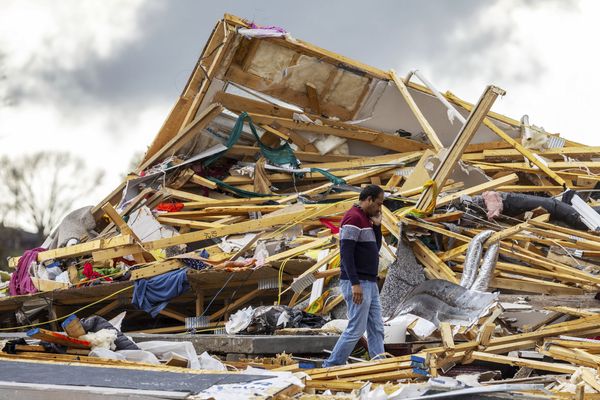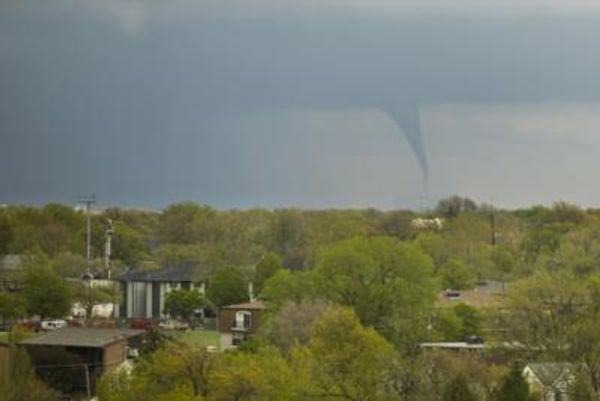
Even as rains drench the fields and orchards in California’s Central Valley where Bill Diedrich grows pistachios, almonds, tomatoes, cotton and other crops, he is still calculating losses from the region’s other defining extreme: severe drought.
Only months ago, it was a shortage of water that forced Diedrich to divert water meant for tomatoes so he could partially hydrate 350 acres (142 hectares) of almond trees. “It’s kind of like not feeding your child all they need,” he said. “Our food security depends on the water supply.”
The atmospheric rivers that have swept over the state — claiming at least 19 lives and dumping 24 trillion gallons of rain since December — would seemingly help that supply. Yet they’ve also shown one of California’s key infrastructure shortcomings as climate change intensifies weather extremes. The state’s outdated water system, designed and built between the 1930s and 1970s, makes it difficult in the current era to capture, store and convey water California needs to remain the dominant US agricultural and economic power.
The record-setting rain has rushed over saturated fields, burst out of river and stream banks, flooded cities and overwhelmed drainage systems, before ultimately washing out to sea.
“Time and time again we see wet years come and go and then wring our hands when it’s dry because we haven’t been able to save enough when it was wet,” said Mike Wade, executive director of the California Farm Water Coalition, a Sacramento nonprofit group.
Since the early 20th century, California’s growth has depended on capturing, storing and transporting immense amounts of water from the northern part of the state and the Sierra Nevada Mountains, where snow provides a water bank for warmer months, to farms in the Central Valley and cities in relatively arid southern California.
From the 1930s through the 1960s, the state and federal governments funded monumental engineering projects, such as the California State Water Project and the Central Valley Project, fueling population and economic growth, and through irrigation, transforming the Central Valley into the world’s most productive agricultural region. Today, the state’s growers produce one-third of US vegetables and 75% of US fruit and nut crops, according to the California Department of Food and Agriculture, generating more than $50 billion in annual revenue.
But the state’s infrastructure was built for a different climate, said Peter Gleick, a climatologist and co-founder at the Pacific Institute, a nonprofit research group in Oakland.
“It’s time to rethink how we operate the existing infrastructure and what kind of new infrastructure we need, given the increasing extreme events that climate change is bringing,” he said.
The systems of dams and aqueducts heralded as engineering marvels in the last century are contributing to current problems, because natural habitats and drainage systems were paved over or diverted, said Ellen Hanak, director of the PPIC Water Policy Center. Excess rain that otherwise could have been absorbed by the ground like a sponge instead gushes into torrential runoff.
Hanak says California’s challenge for the future is to adjust the system to balance ecological and economic interests such as agriculture. Capturing more surface water is one method, but involves building reservoirs and other above-ground structures that are expensive and often difficult to site.
A far more economical and ecologically sound method is to recharge groundwater, typically by channeling water so it can flow into natural underground aquifers that have been over pumped and drained during years of drought. “There is tremendous potential to get more water back in the ground in ways that benefit agricultural and urban users,” said Hanak.
In 2014, California voters approved $7.5 billion in bonds to restore watersheds, improve water quality and water infrastructure, including $2.7 billion in funding for water storage projects. But unlike the grand engineering feats of the last century, today’s California water projects require decades to bring online, with years spent on environmental, regulatory and planning reviews.
Construction has yet to begin on any of the seven projects approved by the California Water Commission, and the new storage structures are scheduled to come online between 2025 and sometime after 2030.
See also: California Drought Conditions Improve After Weeks of Downpour
Governor Gavin Newsom acknowledged concerns about the prolonged time line of the water storage projects authorized in 2014. “The process is leading to paralysis,” Newsom said at a press conference in Sacramento on Tuesday. He said he has appointed “strike teams” to resolve the permitting bottlenecks among local, state and regulatory agencies.
The teams, which meet monthly, are focused on the “non-glamorous” work of speeding up the process of moving through various regulatory and legal requirements of each project, California Natural Resources Secretary Wade Crowfoot said in an interview.
Given the climate crisis, “the status quo isn’t going to work for us right now because these projects need to get online more quickly,” Crowfoot said.
Frustrations, shared by farmers and residents alarmed by worsening extremes, are a recurring theme in California’s water woes.
“During the dry years, the people forgot about the rich years, and when the wet years returned, they lost all memory of the dry years,” John Steinbeck wrote in East of Eden. “It was always that way.” The year was 1952.
©2023 Bloomberg L.P.







